Sharjah, as I would not have known if I hadn’t been here, is one of the seven Emirates of the United Arab Emirates; although that means that it is its own absolute monarchy under its own Sheikh, in practice (or at least to someone from the GT"H"A) it seems to be more or less a suburb of Dubai, which is why we are staying here for convenience before flying out of the Dubai airport.
Today we went to the Sharjah Aquarium, in search of fish.
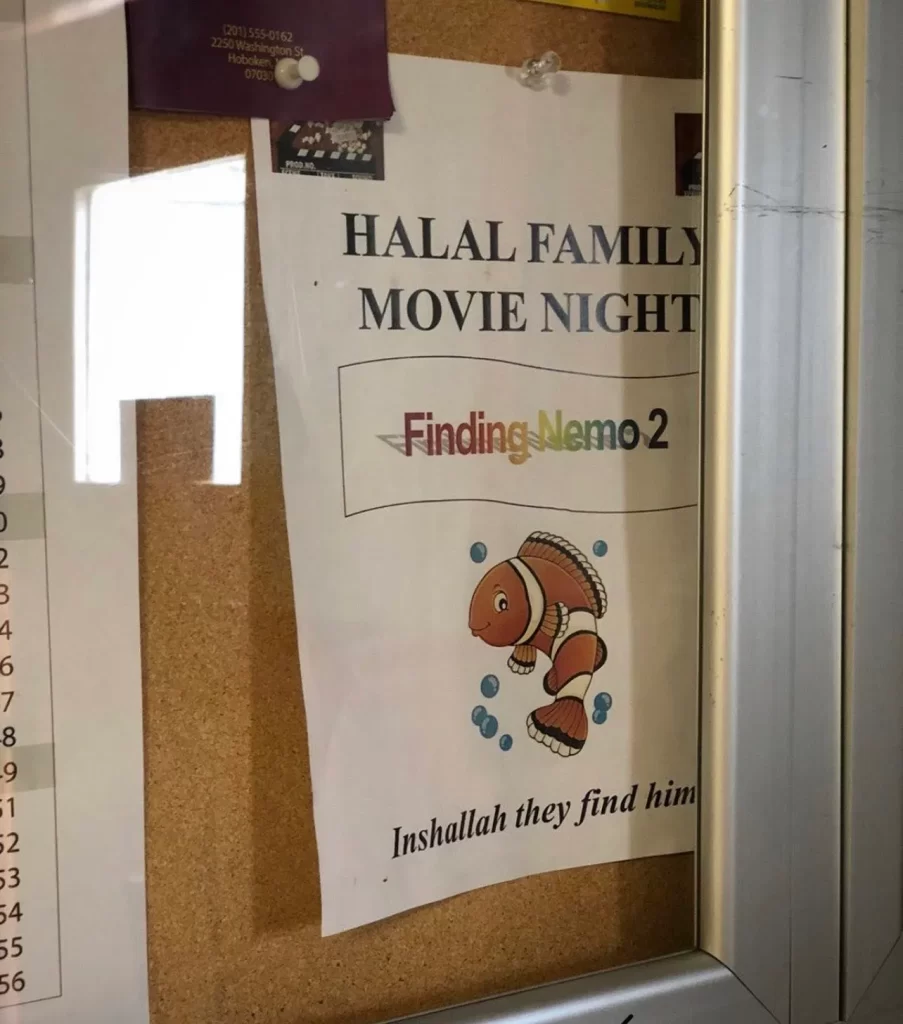
Inshallah they find him finding nemo meme still going strong in 2024?
We did find these guys:



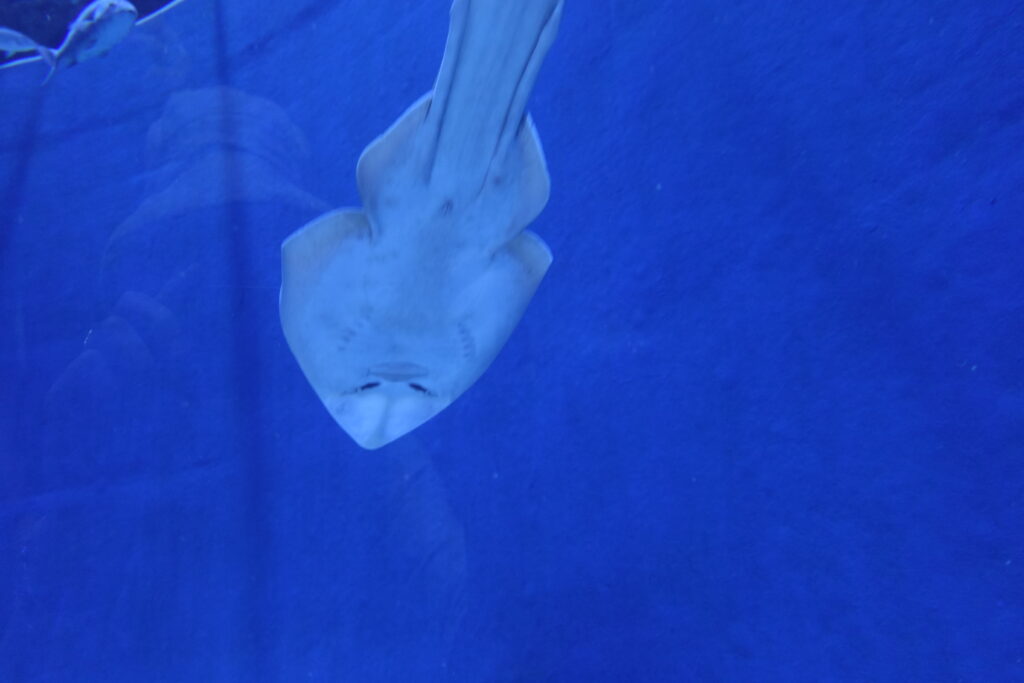
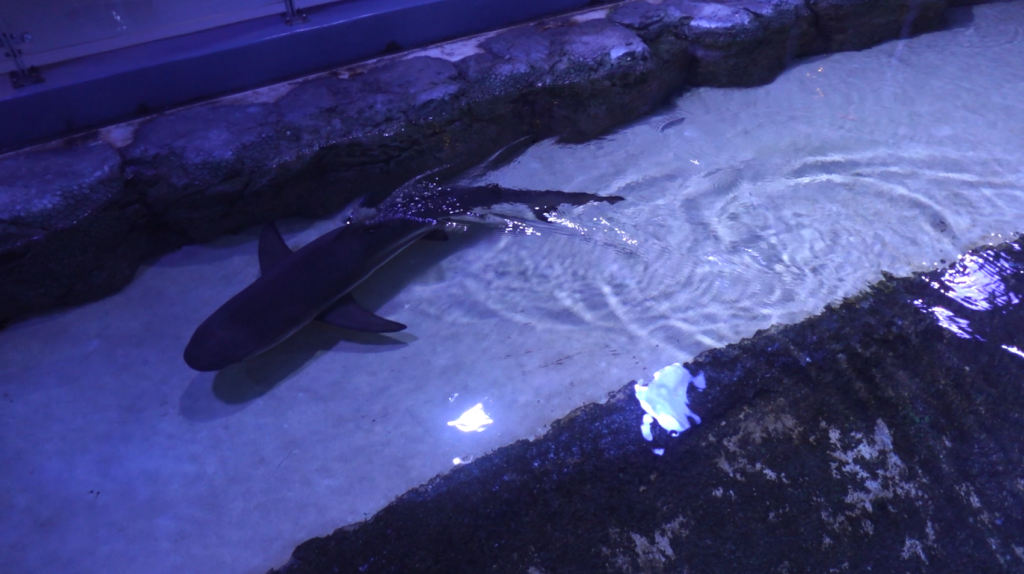
Then we took the water taxi from Sharjah, right outside the aquarium, to Dubai, for dinner:

But more importantly, to meet these guys. Or rather for them to meet me, for they are clearly experts in identifying suckers likely to behave clumsily with small pieces of meat. (Sound on: important meows ahead)
While we’re at it, this guy outside the art gallery we went to in Sharjah, whose dinner was already very well taken care of:

Visiting the Sheikh Zayed Grand Mosque in Abu Dhabi is not like visiting any other religious building that I am aware of. Certainly it was very different from either of the other two enormous mosques we visited, Sohar and Muscat. In Sohar we just walked in, the only visitors during the non-Muslim visiting hours, and could have walked around basically unnoticed if we hadn’t specifically sought out someone to confirm that it was OK to go in all the places it seemed were basically left open for you to go in. In Muscat there was a main tourist gate, with a lobby area that had clothing available to rent or buy, and then after that you could wander where you wanted everywhere except the prayer hall, which had cordoned off walking areas for tourists around the hall.
In Abu Dhabi, the visit starts by reserving an entrance time. When you drive into the complex, you park in an underground lot that looks like it belongs to a shopping mall, because it does belong to a shopping mall. There’s a shopping mall in the mosque complex. After buying any necessary clothing– the dress code is the same as any other mosque, though signs at the entrance also specify a list of other forbidden things, such as teddy bears, suntanning, kissing, and a list of forbidden gestures that does not include the most common North American obscene hand sign– you proceed through a sort of airport security area with metal detectors, and then an even more airport-like corridor with a moving sidewalk and enormous photos of all of the political and religious leaders who have visited the space. Or you can take a taxi down the hallway!

Probably not the best idea to choose pictograms that can be deprecated…
After passing the fresh squeezed orange juice machine (?) you exit into the courtyard of the mosque proper, which has very specific areas where you can and cannot take photos.

The first “photo stop”
And finally, what we’ve been waiting for… the largest carpet in the world!

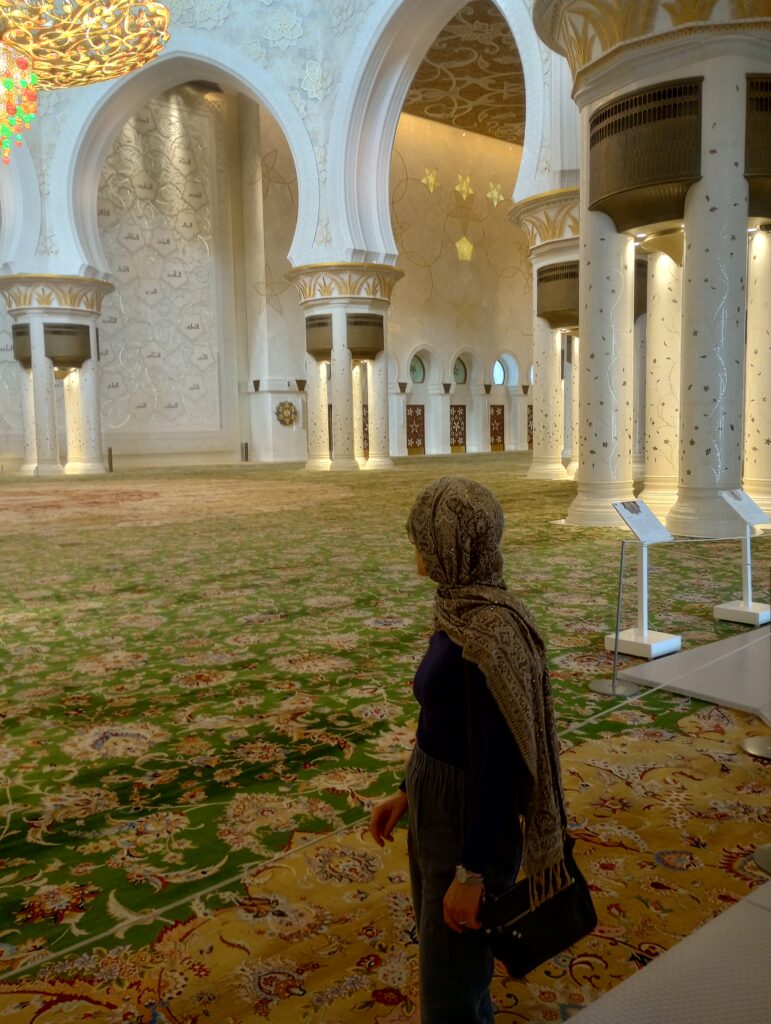
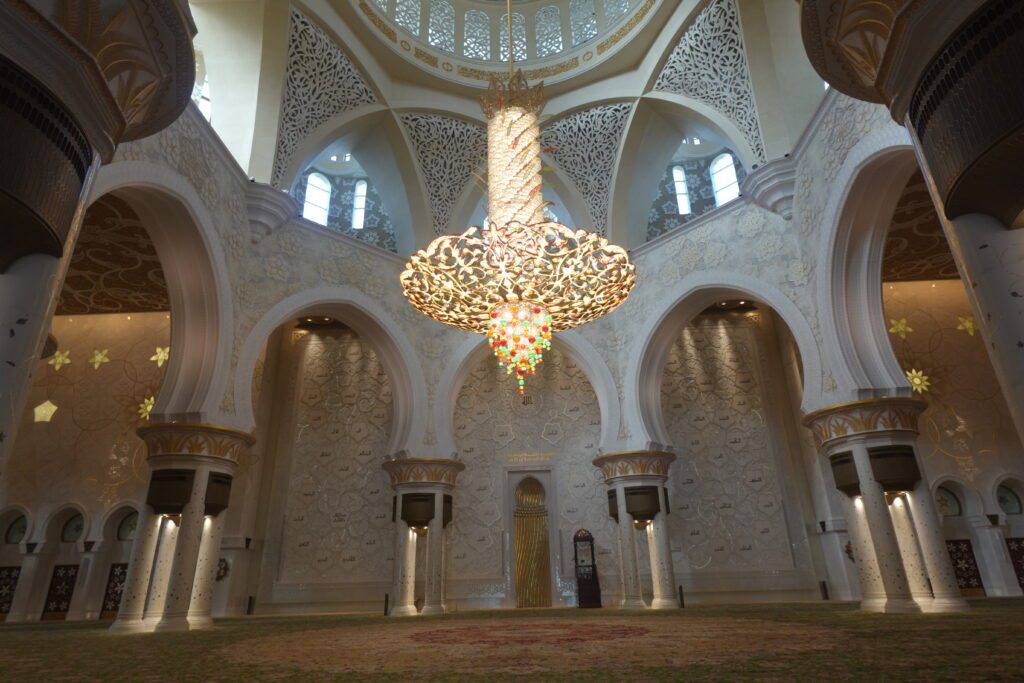
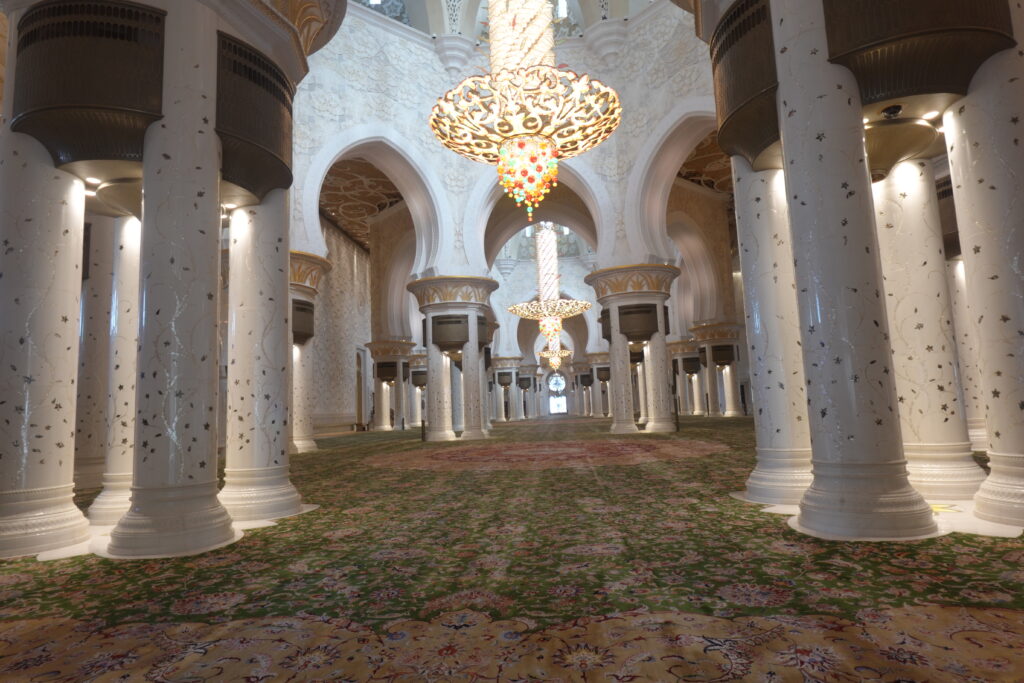
There was a sort of tourist path laid out, with the way through the prayer hall on a raised plastic surface so that you don’t have to take your shoes off. After reaching what seemed to be the final destination of that path, there were still signs that seemed to indicate you could go other places on the enormous grounds; specifically, we decided to try to see the women’s prayer hall– the above hall, of course, is only for men– and also the mausoleum of Zayed bin Sultan Al Nahyan, who ordered the mosque built, died during its construction, and was buried on the grounds.
We were intercepted on our way to the mausoleum by a security guard who said yes, we could go those places, but he would call us a taxi. So we took the buggy to the mausoleum; nobody else was there besides another guard enforcing the no-photos policy of it. Interestingly, the mausoleum was noticeably simple: inside a huge marble enclosure, the founder is buried in a raised box open on the top, so what you see is the pile of dirt on his corpse.
Then we went over to the women’s prayer hall, which a previous security guard had said only women are allowed to enter. (This wasn’t the case in Sohar or Muscat.) So I went up to the security guard outside that room, and asked if I could go in. “For the prayer?” she asked, looking at me like I was insane, since it was 9:45 in the morning. I said no, just to look, and at first she seemed to be saying no, but as I was about to leave she said yes and indicated a separate room to leave my shoes in and again, no photos of the room.
Maybe it was just the contrast with the insane opulence of the rest of the place, but even compared to the two other major mosques we visited, the womens’ room seemed, well, a little neglected? There was a carpet, and an intricate design on the ceiling, but in context it seemed to be making a clear statement that that this was not a place of major importance to, well, anyone of major importance.
Then we took the taxi back through the tourist corridor, and ended our visit at… the mosque mall Tim Hortons.
My issue with car racing as a spectator sport, besides the complete mockery it makes of the effort to de-emphasize the role of the personal automobile as a necessary agent of personal freedom and agency in an effort to still have somewhere for our species to live, is that the range of risks available for the competitors to take that exist within acceptable bounds of non-lethality is extremely small. In most sports, athletes have the option of making visible, noticable and exciting risks: a high-value move that could result in a fall, an audacious steal of the ball or puck, a breakaway that could win the game or leave you worse off than before. The risks of these moves generally range from embarassment to the potential for minor injury. In motor racing, the potential “loss” outcome of any big move that the audience can actually see is fiery death for you and everyone around you. So while arguably just being in a car going that fast is inherently audacious and exciting, it doesn’t exactly look it to me, a person who has seen cars go before, and when the most exciting crazy move that anyone might pull is to intentionally get close to another competitor, there isn’t a lot of room in the “I want to be excited and impressed but not worried about witnessing horrible deaths” space.
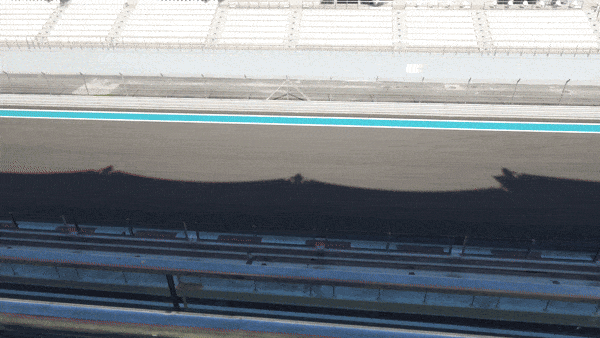
A moment of extreme sporting excitement

Some excitement apparently happened somewhere else
In the afternoon we went to the Louvre Abu Dhabi, which I didn’t take a huge number of photos of, probably because everyone else was. I mean to the point that it was difficult to look at objects, because they were constantly in use as the backgrounds to people’s photos. There was also one of my favourite places, one of the funniest things I have ever seen, one of the many sights of this trip which made me wish David Foster Wallace had lived long enough to see it, which we observed for quite a while whole eating lunch at the cafe: the Hot Girl Observation Deck. The HGOD setup was that a Hot Girl walks out on this runway thing:

A photo captured with difficulty in the brief moment of pause in the Hot Girl lineup
Then, her boyfriend takes photos for her instagram (presumably???) from either the steps or from here:
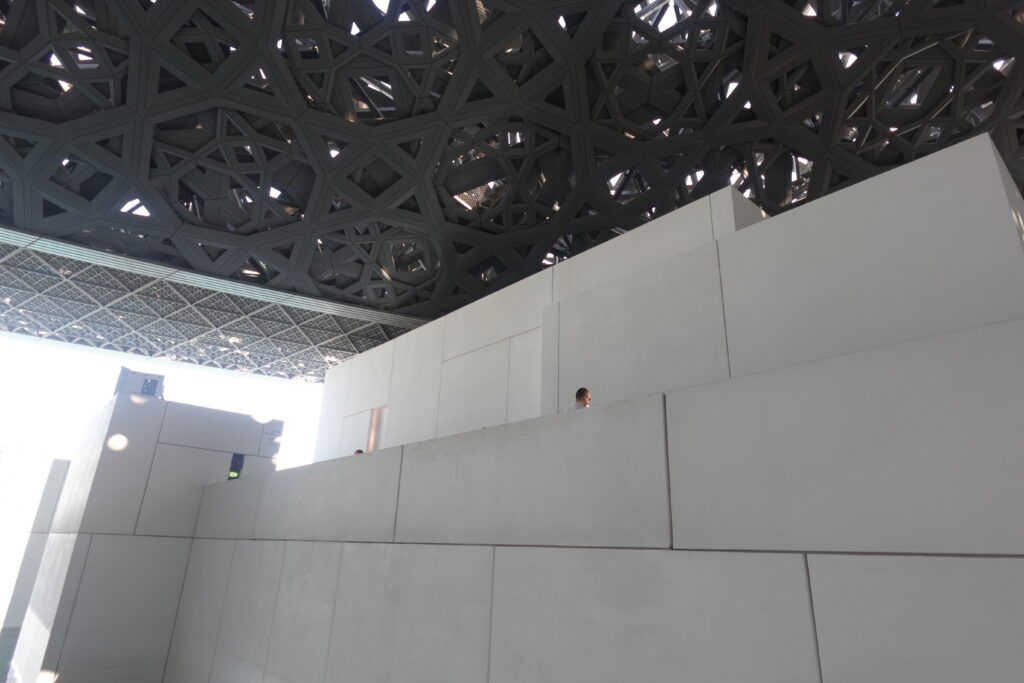
Then they fight about the photos, and if necessary she rejoins the runway lineup to redo them.
This was obviously the intended usage of this piece of architecture, so I can’t really fault them for showing off how hot they are in the show-off-how-hot-you-are-for-instagram place. However, it would be nice if in front of every single work of art were not ALSO the show-off-how-hot-you-are-for-instagram place.

If you ever get too wrapped up in the metaphysics of authenticity, the Dubai Mall Gold Souk wants a word with you. Can a self-conscious recreation of a particular heritage aesthetic, right in the middle of an enormous shopping mall, ever be a “real” example of the kind of thing it’s attempting to recreate?

In North America the answer would be no, go to Tacky Jail for a thousand years. In the Gold Souk, one wonders– okay, if this isn’t the real thing, then what exactly is it? What could possibly make it more “authentic” than it already is? Or rather, what makes things “inauthentic”? If the architecture were made out of cheaper materials than the ones being imitated, perhaps, but clearly no expense has been spared on that front. If it were being used for some purpose other than the one being imitated or by some group other than the ones laying claim to the heritage in question, but in this case it is indeed a place where you can buy gold, precious stones, and perfume for the enrichment of Emirati merchants.

The real purpose of this space seems to be to remind anyone concerned about the authenticity of what they’re viewing: every monument of the ancient world was once an infrastructure project built by a government or individual who wanted to remind you, personally, that sometimes money can in fact buy good taste, or at least buy the ability to determine what good taste is, thank you very much, and hoi polloi are very welcome for the nice place to sit/pray/eat/shop/etc.
Anyway, yesterday we ate breakfast at a place in the middle of it:

And spent a lot of time waiting around in the mall for a place that sold SIM cards to open, before deciding that actually it would be better to just wait out the 24 hour UAE tourist SIM card and then get a longer-term one in Oman. “Waiting around” in the Dubai Mall meant a lot of opportunity to hang out with these guys:
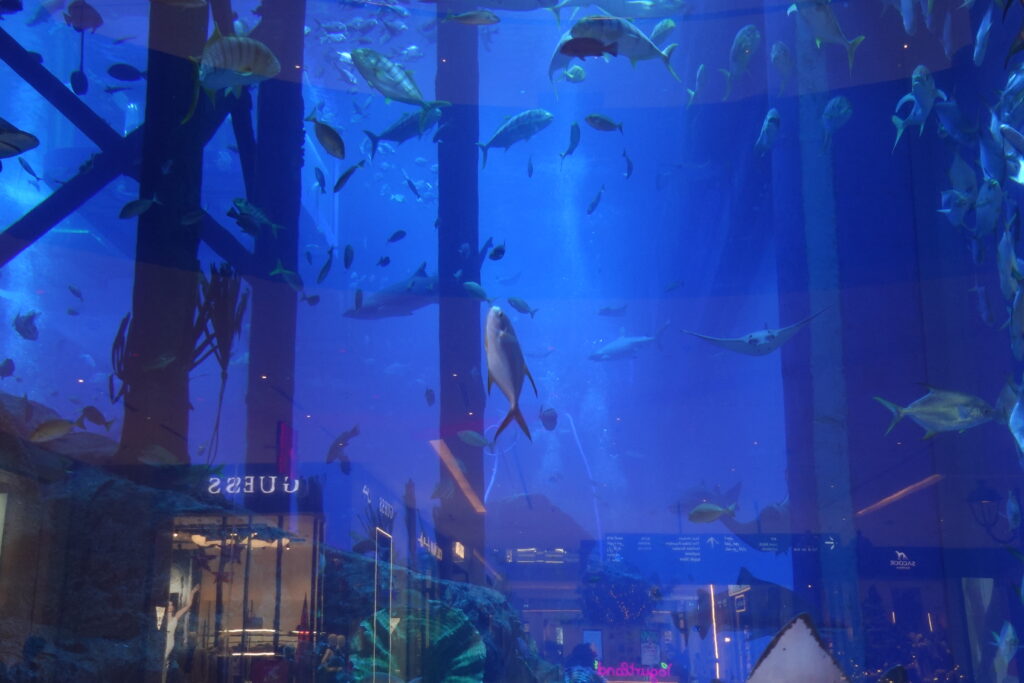
There is an official aquarium tunnel that you can pay to walk through, but the tank is just as visible from the outside of it. We also walked around outside, including to the (outside of the ) opera house; there isn’t anything on at the moment, so this is the closest we could get without paying for a really expensive tour:

Having thoroughly fucked up the get-over-jet-lag-in-Dubai plan by having a four hour nap, we tried to salvage the rest of the day by taking the public transit boat thingy across the creek to Deira:
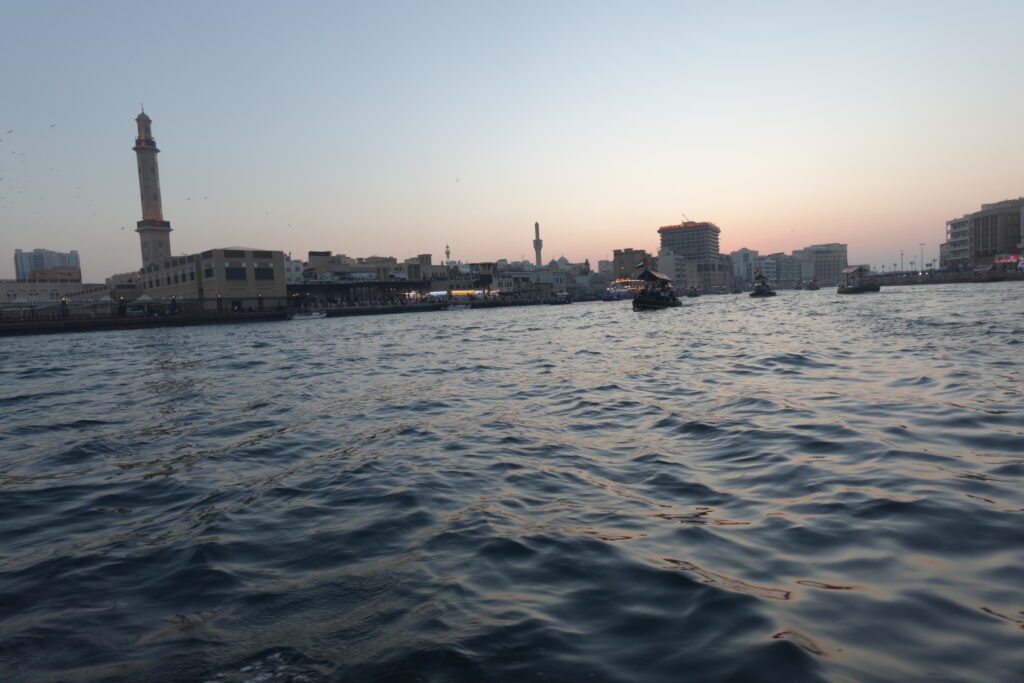
Dubai was just a short stop on the way to the main purpose of the trip, Oman; we flew to Muscat this morning, then picked up a rental car and drove to Sohar, where we’ll be for the next few days.
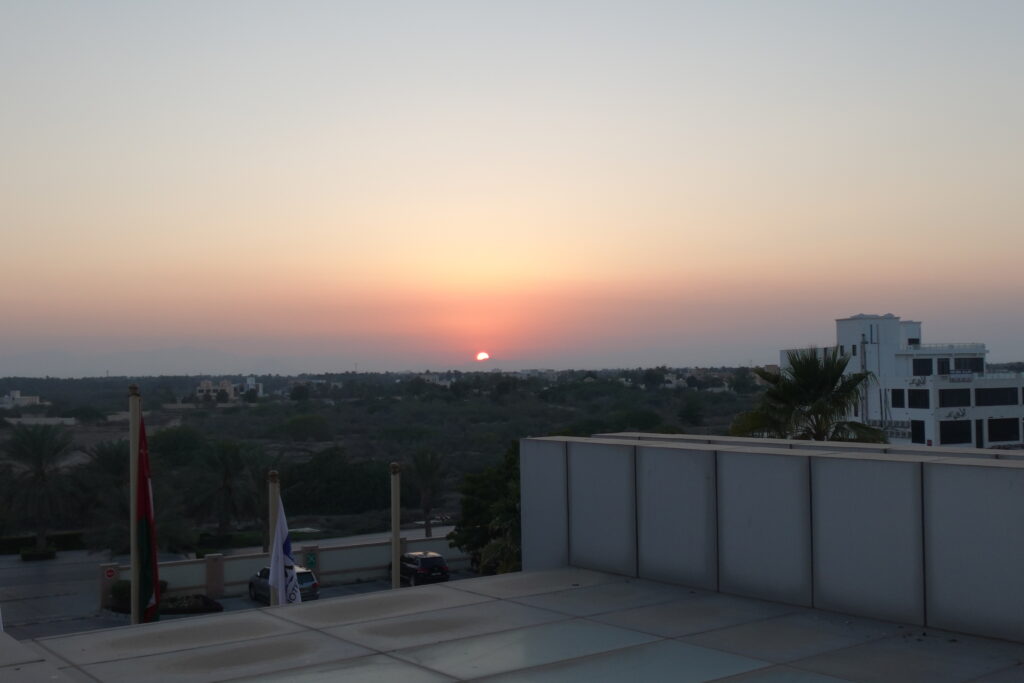

Toronto to Dubai is 12 hours; I tried sampling the in-flight entertainment system, which now has a huge number of titles, but many didn’t have subtitles and you can’t hear anything over the airplane itself, so unsure what the point is. Ended up rewatching stuff where I already knew more or less what they were saying, namely the episodes of Succession in which this guy mops the floor with those rich fucks (“You can’t make a Tomlette without breaking a few Gregs?”)
 Perhaps this was on the mind because my only previous association with Dubai was also this particular guy being really fed up, namely, in the reboot of Interview with the Vampire:
Perhaps this was on the mind because my only previous association with Dubai was also this particular guy being really fed up, namely, in the reboot of Interview with the Vampire:

At the limits of that entertainment I also worked on what I’d meant to be working on for the last year, which was that I’d wanted to at least be able to sound out words in Arabic by the time I spent two weeks in the Middle East. Not exactly for practical purposes– in most of the places we’ll be going, all important signs and directions are transliterated anyway– but it would have been nice to have some mode of interaction with the environment other than wandering around saying “English?” like the north american anglophone tourist I am. However, I spent the past year learning circuit analysis and digital logic, not Arabic, so here we are.
I downloaded an Anki deck for the alphabet, and by the time we got off the plane was able to pan around Oman on OpenStreetMaps (the only one I’d downloaded yet since that’ll be most of the trip) and read the place names with, hmm, perhaps 57% accuracy. Extremely introductory language learners– I have noted many times from the other side– are the absolute worst company, because they are likely to point to any word they recognize in the wild and force a full reckoning of their thought process upon anyone in the vicinity. “Look!” I say, pointing to the sign that also says “Dubai Duty Free” in English right there. “That says ‘Souk Dooty something’!”
The UAE gives all incoming travellers a SIM card that works free for 24 hours, right there when they stamp your passport, which is both a) a thing that the kind of person who prattles about surveillance capitalism and the horrors of the corporate web and uses a VPN and surfs the Fediverse as a primary internet activity would never use, and b) a thing that anyone who has just spent 12 hours on an airplane and was already worrying about having to go find a SIM card first thing is absolutely going to use immediately.
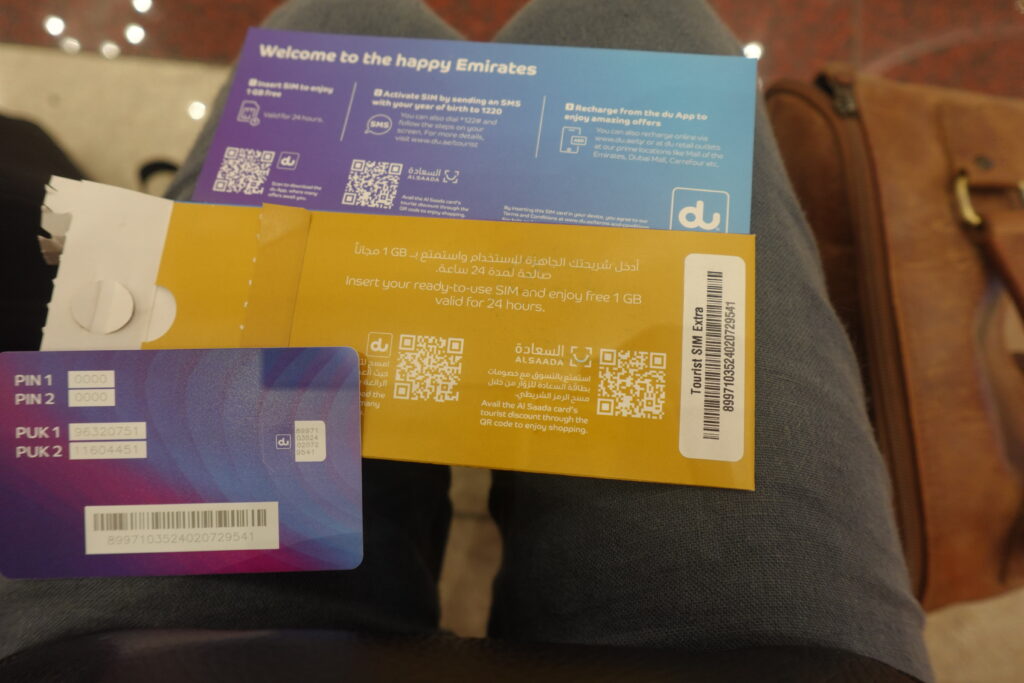
Took the metro (“look! those letters spell ‘metro’!”) to the hotel. Perhaps this is just a function of it being, well, not cold as balls outside, but we were remarking on how the residential area surrounding the hotel, at around 10 PM, had a whole lot of people just hanging around outside in ways that you don’t tend to see in the West; for instance, sitting in circles in the middle of a parking lot outside storefronts selling snacks to fuel your parking-lot-sitting. I got some samosas from one such storefront and brought them back to the hotel to eat while engaging in my usual hotel activity of reading the literature provided beside the bed.
From the first few sections of the English Quran, I remarked in even more irritating fashion that a lot of Arabic words are recognizably, and understandably, derived from ancient Phoenician: for instance بَيت bayt, “house”, which corresponds to the (indeterminately vowelled since the Phoenician writing system was an abjad that only included consonant sounds) “BT” listed in the Xeroxed 1974 dissertation on the Phoenician and Punic languages lying around on my computer somewhere. Similarly, the Gideon Quran’s footnote on the use of the word رب rab, “lord/master,” which made me suddenly remember that that was the title applied to Carthaginian political leaders. Which is practically the only words I know in either of those languages, so not exactly conclusive, but (doofenshmirtz voice) it’s weird that it’s happened twice!



























 Perhaps this was on the mind because my only previous association with Dubai was also this particular guy being really fed up, namely, in the reboot of Interview with the Vampire:
Perhaps this was on the mind because my only previous association with Dubai was also this particular guy being really fed up, namely, in the reboot of Interview with the Vampire:
